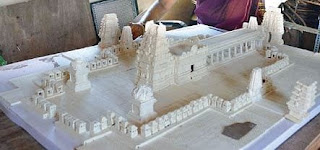Thanjavur Netti Works (Thanjavur Pith Work) is made from pith. The pith is obtained from Netti or Sholapith, a hydrophyte plant. The artisans are skilled in this particular craft and this art is traditionally and hereditarily transferred from their fore-fathers. The distinctness of the Pith artifact’s remains in the simplicity of its production.
Netti is a dried milky white spongy plant material. The biological name of Netti is 'Aeschynomene indica' or 'Aeschynomene aspera'. The 'netti' is the cortex or core of the plant and is about 1 ½ inch in diameter
The notable works from Thanjavur Netti Works include models of the Brihadeeshwara Temple, Hindu Idols, Garlands, door hangings and show pieces used for decoration. Miniatures of rural and urban place are also made, which are decorated with lights
Image credit: thebusinessads.com
The artifact’s created out of the pith looks similar to the ones made in marble and to the ones made in elephant’s tusk. They shine in a very elegant way. However, products made from the Pith are brittle and break easily, unless kept carefully. Hence, most models are preserved inside a glass box.
Artisans are trained and engaged in this business for generations. Knowledge and skill is passed traditionally from one generation to another through 'Guru Shishya' method. Pith doesn't require any mould or supporting instruments to create desired shapes unlike metal scriptures. It requires basic tools such as knives, scissors and geometric tools box to mould it.
The root is boiled, and dried in the sun. The brown cover of the hydrophyte is sliced and removed using an appropriate knife. The inner soft white portion of the stem is used to make the art pieces. Only ivory coloured pith is selected and processed further. If pith is of colour which is not of standard quality it is discarded.
Thereafter using knife as an only tool, pith is sliced into equal dimensions. It is done in such detailing that every slice is of equal dimensions so that there is no disparity when artifacts is being compiled. Individual sub structures of the models are made and structured using the home-made paste. The raw tendrils of the reed are boiled, ground and mixed with flour to make the glue paste.
Then sculpture or design is structured on it by the artisans. It is then cut to size and a pencil drawing is inscribed on it. A rough carving is followed by the carving of finer details with a blunt chisel and it is polished with sandpaper finally.
The finished pith work is generally fixed to a wooden base and covered with glass to protect from dust and moisture. This helps to preserve the works for years. For normal pieces ply wood made stands are used as base, whereas for big and important pieces teak and wood stands are used.
GI Tag Registration Date : 14 September 2021
GI Tag Number : 423
Certificate Number : 367
Geographical Area : Tamil Nadu
Special Cover Release Date : 09 March 2022
Cancellation : Tiruchirappalli 620 001
Type : GI Tag Cover
Cover Identification Number : TN/05/2022
Brihadeeswara Temple model made of Thanjavur Netti Works is pasted on the cover. Only 1000 covers are issued and each cover is numbered. This cover is issued with protection presentation cover with image of Pith plant.
Enlarged View of Protection Cover
Enlarged View of Illustration
Enlarged View of Cancellation
Back Side Scan







No comments:
Post a Comment